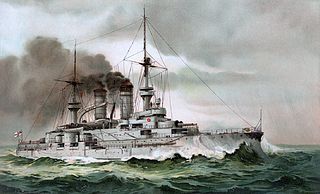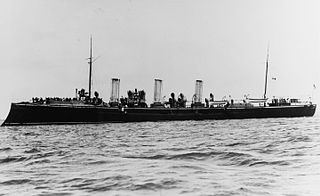
SMS Friedrich der Grosse was an ironclad turret ship built for the German Kaiserliche Marine. She was the second of three Preussen-class ironclads, in addition to her two sister-ships Preussen and Grosser Kurfürst. Named for Frederick the Great, she was laid down at the Imperial Dockyard in Kiel in 1871 and completed in 1877. Her main battery of four 26 cm (10 in) guns was mounted in a pair of twin gun turrets amidships.

SMS Siegfried was the lead ship of the six-member Siegfried class of coastal defense ships built for the German Imperial Navy. Her sister ships were Beowulf, Frithjof, Heimdall, Hildebrand, and Hagen. Siegfried was built by the Germaniawerft shipyard between 1888 and 1890, and was armed with a main battery of three 24-centimeter (9.4 in) guns. She served in the German fleet throughout the 1890s and was rebuilt in 1903 - 1904. She served in the VI Battle Squadron after the outbreak of World War I in August 1914, but saw no action. Siegfried was demobilized in 1915 and used as a barracks ship thereafter. She was ultimately broken up for scrap in 1920.

SMS Zähringen was the third Wittelsbach-class pre-dreadnought battleship of the German Imperial Navy. Laid down in 1899 at the Germaniawerft shipyard in Kiel, she was launched on 12 June 1901 and commissioned on 25 October 1902. Her sisters were Wittelsbach, Wettin, Schwaben and Mecklenburg; they were the first capital ships built under the Navy Law of 1898, brought about by Admiral Alfred von Tirpitz. The ship, named for the former royal House of Zähringen, was armed with a main battery of four 24 cm (9.4 in) guns and had a top speed of 18 knots.

SMS Wörth was one of four German pre-dreadnought battleships of the Brandenburg class, built in the early 1890s. The class also included Brandenburg, Kurfürst Friedrich Wilhelm, and Weissenburg. The ships were the first ocean-going battleships built for the Kaiserliche Marine. Wörth was laid down at the Germaniawerft dockyard in Kiel in May 1890. The ship was launched on 6 August 1892 and commissioned into the fleet on 31 October 1893. Wörth and her three sisters carried six heavy guns rather than four, as was standard for most other navies' battleships. She was named for the Battle of Wörth fought during the Franco-Prussian War of 1870–1871.

SMS Brandenburg was the lead ship of the Brandenburg-class pre-dreadnought battleships, which included Kurfürst Friedrich Wilhelm, Weissenburg, and Wörth, built for the German Kaiserliche Marine in the early 1890s. She was the first pre-dreadnought built for the German Navy; earlier, the navy had only built coastal defense ships and armored frigates. The ship was laid down at the AG Vulcan dockyard in 1890, launched on 21 September 1891, and commissioned into the German Navy on 19 November 1893. Brandenburg and her three sisters were unique for their time in that they carried six heavy guns instead of the four that were standard in other navies. She was named after the Province of Brandenburg.

SMS Kaiser Friedrich III was the lead ship of the Kaiser Friedrich III class of pre-dreadnought battleships. She was laid down at the Kaiserliche Werft in Wilhelmshaven in March 1895, launched in July 1896, and finished in October 1898. The ship was armed with a main battery of four 24-centimeter (9.4 in) guns in two twin gun turrets supported by a secondary battery of eighteen 15 cm (5.9 in) guns.

SMS Kaiser Karl der Grosse was a German pre-dreadnought battleship of the Kaiser Friedrich III class, built around the turn of the 20th century for the Kaiserliche Marine. Named for the Emperor Charlemagne, Kaiser Karl der Grosse was built in Hamburg, at the Blohm and Voss shipyard. She was laid down in September 1898 and launched in October 1899. A shipyard strike and an accidental grounding delayed her completion until February 1902; she was therefore the last member of her class to enter service. The ship was armed with four 24-centimeter (9.4 in) guns in two twin gun turrets and had a top speed of 17.5 knots.

SMS Kaiser Wilhelm der Grosse was a German pre-dreadnought battleship of the Kaiser Friedrich III class, built around the turn of the 20th century. The ship was one of the first battleships built by the German Imperial Navy as part of a program of naval expansion under Kaiser Wilhelm II. Kaiser Wilhelm der Grosse was built in Kiel at the Germaniawerft shipyard. She was laid down in January 1898, launched in June 1899, and completed in May 1901. The ship was armed with a main battery of four 24-centimeter (9.4 in) guns in two twin turrets.

SMS Wittelsbach was the lead ship of the Wittelsbach class of pre-dreadnought battleships, built for the Imperial German Navy. She was the first capital ship built under the Navy Law of 1898, brought about by Admiral Alfred von Tirpitz. Wittelsbach was laid down in 1899 at the Wilhelmshaven Navy Dockyard and completed in October 1902. She was armed with a main battery of four 24 cm (9.4 in) guns and had a top speed of 18 knots.

SMS Wettin was a pre-dreadnought battleship of the Wittelsbach class of the German Kaiserliche Marine. She was built by Schichau Seebeckwerft in Danzig. Wettin was laid down in October 1899, and was completed October 1902. She and her sister ships—Wittelsbach, Zähringen, Schwaben and Mecklenburg—were the first capital ships built under the Navy Law of 1898. Wettin was armed with a main battery of four 24 cm (9.4 in) guns and had a top speed of 18 knots.

SMS Württemberg was one of four Sachsen-class armored frigates of the German Kaiserliche Marine. Her sister ships were Sachsen, Bayern, and Baden. Württemberg was built in the AG Vulcan shipyard in Stettin from 1876 to 1881. The ship was commissioned into the Imperial Navy in August 1881. She was armed with a main battery of six 26 cm (10.2 in) guns in two open barbettes.

SMS Kronprinz was a unique German ironclad warship built for the Prussian Navy in 1866–1867. Kronprinz was laid down in 1866 at the Samuda Brothers shipyard at Cubitt Town in London. She was launched in May 1867 and commissioned into the Prussian Navy that September. The ship was the fourth ironclad ordered by the Prussian Navy, after Arminius, Prinz Adalbert, and Friedrich Carl, though she entered service before Friedrich Carl. Kronprinz was built as an armored frigate, armed with a main battery of sixteen 21 cm (8.3 in) guns; several smaller guns were added later in her career.

SMS Danzig was a light cruiser of the Imperial German Navy. Named for the city of Danzig, she was the seventh and last ship of the Bremen class. She was begun by the Imperial Dockyard in her namesake city in 1904, launched on 23 September 1905 and commissioned on 1 December 1907. Armed with a main battery of ten 10.5 cm (4.1 in) guns and two 45 cm (18 in) torpedo tubes, Danzig was capable of a top speed of 22 knots.

SMS Baden was one of four Sachsen-class armored frigates of the German Kaiserliche Marine. Her sister ships were Sachsen, Bayern, and Württemberg. Baden was built in the Kaiserliche Marine in Kiel from 1876 to 1883. The ship was commissioned into the Imperial Navy in September 1883. She was armed with a main battery of six 26 cm (10.2 in) guns in two open barbettes.

SMS Greif was an aviso built for the German Kaiserliche Marine in the mid-1880s, the only ship of her class. Designed at a time where torpedoes had become effective weapons and spurred the development of the Jeune École, Greif was intended to guard the capital ships of the fleet against torpedo boat attacks. For this role, she carried a battery of 10.5 cm (4.1 in) and 3.7 cm (1.5 in) guns, unlike other German avisos of the period, which also carried torpedo tubes. Greif was not a successful warship, however, and she spent much of her career laid up, out of service.

SMS Zieten was the first torpedo-armed aviso built for the Imperial German Navy. She was built in Britain in 1875–1876, and was the last major warship built for Germany by a foreign shipyard. Ordered as a testbed for the new Whitehead torpedo, Zieten was armed with a pair of 38 cm (15 in) torpedo tubes, and was capable of a top speed of 16 knots, making her the fastest ship in the German fleet at the time. Zieten was the first torpedo-armed vessel in a series of avisos that ultimately developed into the first light cruisers. In addition to her impact in German warship design, Zieten also influenced numerous other navies, who built dozens of similar avisos and torpedo vessels of their own.

The Bismarck-class corvettes were a class of six corvettes built for the German Kaiserliche Marine in the 1870s. The six ships were Bismarck, Blücher, Stosch, Moltke, Gneisenau, and Stein. The Bismarck-class corvettes were ordered as part of a major naval construction program in the early 1870s, and they were designed to serve as fleet scouts and on extended tours in Germany's colonial empire. The ships were armed with a battery of between ten and sixteen 15 cm (5.9 in) guns and they had a full ship rig to supplement their steam engine on long cruises abroad. One ship, Blücher, was converted into a torpedo testing and training ship shortly after she was completed, having her guns replaced with a variety of torpedo launchers.

SMS Blitz was an aviso of the German Kaiserliche Marine built in the early 1880s. She was the lead ship of her class, which included one other vessel, SMS Pfeil. Her primary offensive armament consisted of a bow-mounted torpedo tube, and she was armed with a battery of light guns to defend herself against torpedo boats, a sign of the growing importance of torpedoes as effective weapons in the period. The Blitz class featured a number of innovations in German warship design: they were the first steel hulled warships and the first cruiser-type ships to discard traditional sailing rigs.

SMS Meteor was an aviso of the German Kaiserliche Marine built in the late 1880s and early 1890s, the lead ship of her class that include one other vessel, Comet. Intended to screen the main fleet against attacking torpedo boats, Meteor was armed with a battery of four 8.8 cm (3.5 in) guns. Her design suffered from several defects, including excessive vibration and poor handling in heavy seas, both of which could not be corrected. These problems limited the ship's career. She served briefly as a guard ship in Kiel in 1892, as an aviso with the main fleet in 1893–1894, and as a fishery protection ship in 1895–1896. Out of service by the end of 1896, Meteor was later used as a harbor defense vessel in 1904 and then as a barracks ship from 1911 to 1919, when she was sold to ship breakers and dismantled.

SMS Wacht was an aviso of the Imperial German Navy, the lead ship of her class. She had one sister ship, Jagd. Wacht was built by the AG Weser shipyard; she was laid down in 1886, launched in August 1887, and commissioned in August 1888. She served in the active fleet through the 1890s and participated in numerous training exercises. Her career was cut short on 4 September 1901, when she collided with the old ironclad SMS Sachsen. The latter's ram bow holed Wacht under the waterline and caused her to rapidly sink. Her crew was safely rescued, however, and there were no casualties.





















